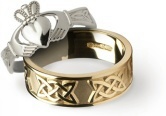Boyne Valley
 |
| Oldbridge Estate in Ireland's Boyne Valley |
The History and Mythology of The Boyne Valley
The Boyne Valley is an important historical site located in the northeastern part of Ireland. This massive valley encompasses the counties of Meath and Louth. The Boyne Valley is considered a World Heritage Site and is one of the largest located in Europe. There is a combination of heritage, myth, history, and magic that make the Boyne Valley one of Ireland's finest tourist destinations.
Goddess of the River Boyne - Boann
The River Boyne runs through the Boyne Valley and is named after the Goddess of the River Boyne, Boann. Boann is recognized as the Celtic goddess of healing, bounty, and fertility. Boann’s husband was the water god, Nechtan. She was also linked to Dagda, who helped her birth the god of love. The myth suggests that Boann concealed her union with Dagda, from Nechtan, by making the sun stand still for nine months. This allowed the god of love, Oenghus, to be conceived and born within the same day.
The myth surrounding Boann believes there was a magical well that contained the source of knowledge. This well was called the Well of Wisdom (or the Well of Segais). All were forbidden to approach it. However, Boann’s husband and his servants were permitted. The myth suggests that Boann approached the magical well and lifted the cover. This act was believed to violate the purity of the well. The waters inside the well surged and violently erupted into a powerful river that consumed her. In some accounts of the myth, Boann drowned. In others, Boann outran the waters. While the truth behind the myth is still debated today, the river became known as the Boyne after the Goddess Boann.
Salmon of Knowledge
The Salmon of Knowledge is a well-known myth throughout Irish mythology. According to the myth, there was only one creature wiser than man. This creature’s name was Fintan. The myth varies on whether Fintan was an ordinary fish or one of the Immortals. If Fintan was truly one of the Immortals, the fish would be eaten yet remain alive.
According to the myth, a normal salmon consumed nine of the hazelnuts that fell into the Well of Wisdom. This is the same well that immersed the goddess Boann and created the River Boyne. The myth believes that by eating the hazelnuts, the salmon received all of the world's knowledge. More importantly, the first person to eat the salmon’s flesh would gain all of the knowledge.
After seven years of fishing, Finn Eces finally found the salmon. When Finn Eces caught Fintan, he gave the salmon to his servant, Fionn mac Cumhaill, with orders not to eat the fish. However, while Fionn was cooking the salmon, he burned his thumb on a drop of fish fat. After Fionn sucked his burnt thumb to ease the pain, he gained all of the wisdom of the salmon. Although he was unaware that all of Fintan's knowledge was concentrated into that drop of fish fat; he took the cooked fish to Finn Eces. When Finn Eces recognized that Fionn had received the wisdom of the salmon, he gave him the fish to eat. After eating the salmon, Fionn could pull up banks of knowledge by simply biting his thumb. Fionn later became a great leader and devoted his life to spreading wisdom throughout Ireland.
World Heritage Site
Located near the medieval town of Drogheda, the passage tombs of Newgrange are Ireland's best known prehistoric monument. In Irish mythology they are said to be the home of Oenghus, the God of love. The monument at Newgrange, along with those of Knowth and Dowth, were designated a World Heritage site in 1993 by UNESCO. The Loughcrew passage tombs near Oldcastle are another significant historical site located within the Boyne Valley.
Also near Drogheda are the historic sites of Monasterboice, a fascinating monastic site with the two finest Celtic Crosses in Ireland, and Mellifont Abbey, the first Cistercian abbey built in Ireland.
The short course of the River Boyne also winds past famous historical sites such as Trim Castle, The Hill of Tara and The Hill of Slane.
Battle of the Boyne
The infamous yet pivotal Battle of the Boyne occurred on July 1, 1690. This was a battle between King William III and his father-in-law, King James II. This battle occurred across the River Boyne on the eastern coast of Ireland near Drogheda. The battle was ultimately won by William III. This victory was the deciding factor in King James II attempting to regain the crown. More importantly, this victory ensured Protestant superiority in Ireland.
This battle witnessed the largest number of troops ever deployed in an Irish battle. King William III was victorious because his troops were more equipped and better trained. William III set up camp on the north side of the River while James II set up camp on the south. The battle was fought over control of a ford at Oldbridge and the casualties were around 2,000.
The Boyne Valley is rich in history and heritage. There is a mixture of myth and history that create an engaging atmosphere for any visitor. The Boyne Valley is truly a tourist destination that will not disappoint.
